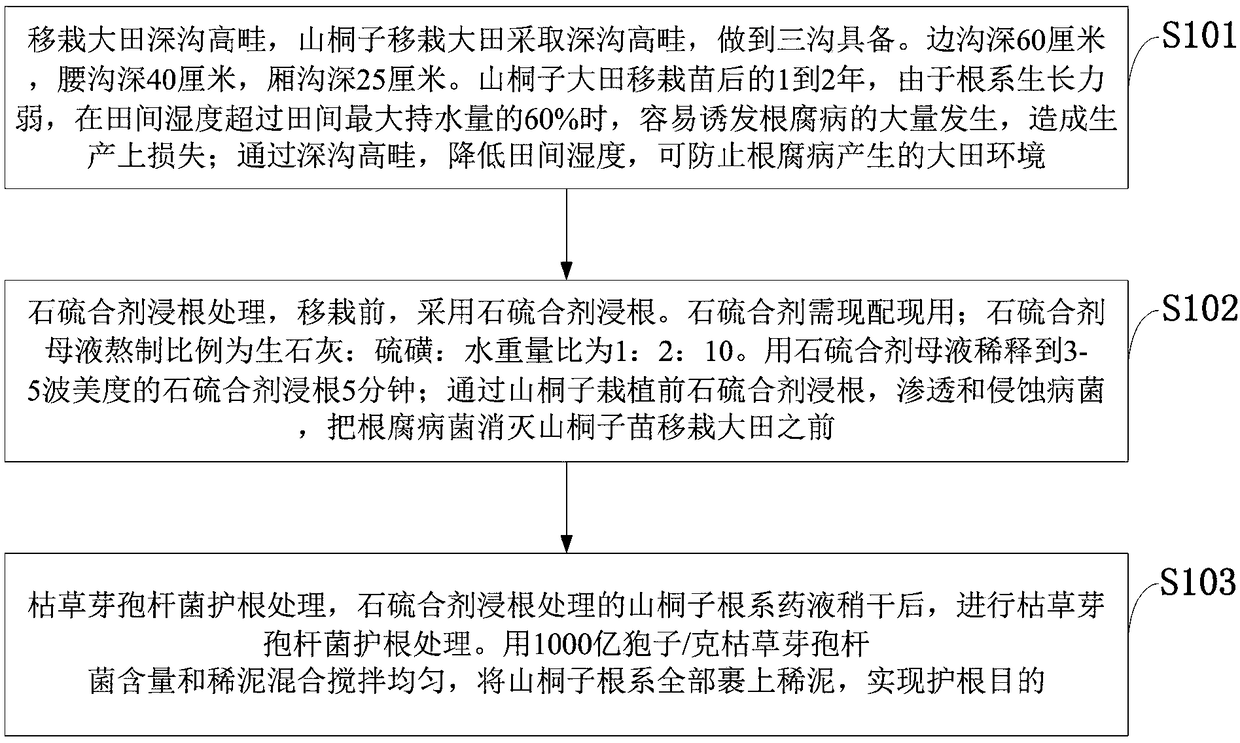Prevention and treatment method for root rot of idesia polycarpa maxim seedlings transplanted in field
A technology for root rot and S. japonica is applied in the field of root rot prevention and control of transplanted seedlings in S. japonica field.
- Summary
- Abstract
- Description
- Claims
- Application Information
AI Technical Summary
Problems solved by technology
Method used
Image
Examples
Embodiment 1
[0026] In 2014, in Hehua Village, Shaxi Township, Lichuan City, Hubei Province, a test of root rot control methods for transplanted seedlings of Jasminia japonica in field was carried out. The test area is 50 mu.
[0027] 1. Transplanting field deep ditch high border
[0028] On December 1, 2014, the field transplanted seedlings of Jatropha japonica began to prepare the soil and apply base fertilizer. Apply 150kg of decomposed rapeseed cake fertilizer and 50kg of compound fertilizer per mu as base fertilizer. Prepare the land with three ditches. The side ditch is 60 cm deep, the waist ditch is 40 cm deep, and the box ditch is 25 cm deep. The jatropha is transplanted into the field to adopt deep ditch and high border, which is conducive to drainage.
[0029] 2. Lime sulfur mixture root soaking treatment
[0030] On December 25, 2014, before transplanting in the field, the roots were soaked with lime sulfur. Lime sulfur mixture needs to be prepared and used immediately. L...
Embodiment 2
[0036] In 2015, in Tianmenmen Village, Wenquan Town, Yingshan County, Hubei Province, a test of root rot control methods for transplanted seedlings of Jasmine japonica was carried out. The test area is 20 mu.
[0037] 1. Transplanting field deep ditch high border
[0038]On December 5, 2015, the field transplanted seedlings of Jatropha japonica began to prepare the soil and apply basal fertilizer. Apply 150kg of decomposed rapeseed cake fertilizer and 50kg of compound fertilizer per mu as base fertilizer. Prepare the land with three ditches. The side ditch is 60 cm deep, the waist ditch is 40 cm deep, and the box ditch is 25 cm deep. The jatropha is transplanted into the field to adopt deep ditch and high border, which is conducive to drainage.
[0039] 2. Lime sulfur mixture root soaking treatment
[0040] On December 20, 2015, before transplanting in the field, the roots were soaked with lime sulfur. Lime sulfur mixture needs to be prepared and used immediately. Lime ...
Embodiment 3
[0046] In 2017, in Jinling Village, Xincheng Town, Dawu County, Hubei Province, a test of root rot control methods for transplanted seedlings of Jasmine japonica in field was carried out. The test area is 40 mu.
[0047] 1. Transplanting field deep ditch high border
[0048] On December 8, 2016, the transplanted seedlings of Jatropha japonica in the field began to prepare the soil and apply basal fertilizer. Apply 150kg of decomposed rapeseed cake fertilizer and 50kg of compound fertilizer per mu as base fertilizer. Prepare the land with three ditches. The side ditch is 60 cm deep, the waist ditch is 40 cm deep, and the box ditch is 25 cm deep. The jatropha is transplanted into the field to adopt deep ditch and high border, which is conducive to drainage.
[0049] 2. Lime sulfur mixture root soaking treatment
[0050] On December 28, 2016, before transplanting in the field, the roots were soaked with lime sulfur. Lime sulfur mixture needs to be prepared and used immediat...
PUM
 Login to View More
Login to View More Abstract
Description
Claims
Application Information
 Login to View More
Login to View More - R&D
- Intellectual Property
- Life Sciences
- Materials
- Tech Scout
- Unparalleled Data Quality
- Higher Quality Content
- 60% Fewer Hallucinations
Browse by: Latest US Patents, China's latest patents, Technical Efficacy Thesaurus, Application Domain, Technology Topic, Popular Technical Reports.
© 2025 PatSnap. All rights reserved.Legal|Privacy policy|Modern Slavery Act Transparency Statement|Sitemap|About US| Contact US: help@patsnap.com

